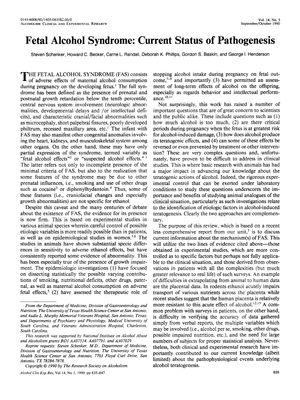Fetal Alcohol Syndrome: Current Status of Pathogenesis
October 1990
in “
Alcoholism/Alcoholism, clinical and experimental research
”

TLDR The document concludes that the exact way alcohol causes harm to fetal development is unknown, but it significantly affects nutrient transport to the fetus and a safe level of alcohol during pregnancy is not determined.
The document from 1990 examines the pathogenesis of Fetal Alcohol Syndrome (FAS), emphasizing the teratogenic effects of maternal alcohol consumption during pregnancy. It discusses the variability in species sensitivity to alcohol and the difficulty in determining a safe level of alcohol consumption during pregnancy. The review explores the roles of ethanol toxicity, acetaldehyde toxicity, impaired nutrition, and the synergistic effects of other substances. It also considers specific mechanisms such as fetal hypoxia, prostaglandin formation, and direct effects on cell development. The document notes that while malnutrition may not be necessary for ethanol-induced fetal damage, it could contribute to the injury. It also highlights the effects of ethanol on nutrient transport across the placenta, with studies showing that ethanol can inhibit the transport of amino acids, glucose, vitamins, and trace metals, which are essential for fetal development. The paper concludes that the specific mechanisms by which alcohol impairs fetal growth and development are unknown, but the effects on nutrient transport are a significant concern, necessitating further research. Additionally, the document explores hypotheses for the effects of alcohol on fetal development, including hypoxia, prostaglandins, and direct cellular effects, and emphasizes the importance of critical periods and threshold doses in alcohol teratogenesis. Epidemiological studies suggest a risk for abnormalities in offspring of mothers who consume significant amounts of alcohol, but a clear threshold for safe consumption has not been established. The review concludes that the pathogenesis of FAS is still undefined, with a variety of factors potentially involved, and the search for predisposing factors to FAS is in its early stages.